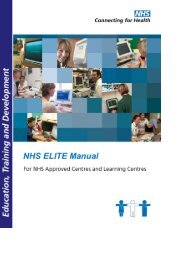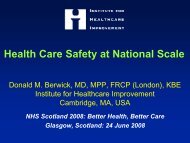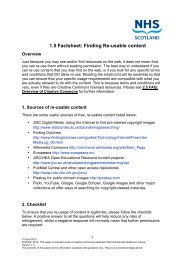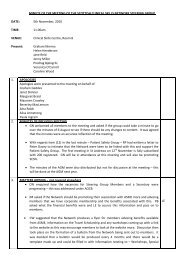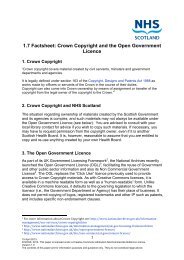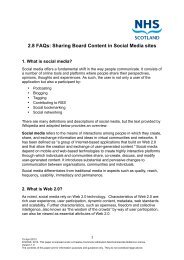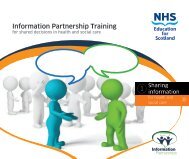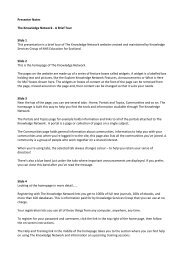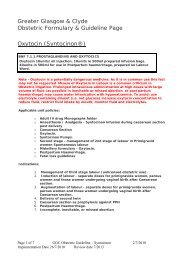AHRQ NRC Evaluation Toolkit (3)
AHRQ NRC Evaluation Toolkit (3)
AHRQ NRC Evaluation Toolkit (3)
Create successful ePaper yourself
Turn your PDF publications into a flip-book with our unique Google optimized e-Paper software.
<strong>Evaluation</strong> <strong>Toolkit</strong><br />
Version 3<br />
Agency for Healthcare Research and Quality<br />
National Resource Center for Health Information Technology
Caitlin M. Cusack MD MPH<br />
Center for IT Leadership,<br />
Partners Healthcare, Boston MA<br />
Eric G. Poon MD MPH<br />
Brigham and Women’s Hospital<br />
Partners Healthcare, Boston, MA<br />
The authors are indebted to members of the National Resource Center’s Value and <strong>Evaluation</strong><br />
Team for their invaluable input and feedback: Davis Bu MD MA (Center for IT Leadership),<br />
Karen Cheung MPH (National Opinion Resource Center ), Dan Gaylin MPA (National Opinion<br />
Resource Center), Julie McGowan PhD (The Regenstrief Institute), Adil Moiduddin MPP<br />
(National Opinion Resource Center), Anita Samarth (eHealth Initiative), Jan Walker RN, MBA<br />
(Center for IT Leadership), and Atif Zafar MD (The Regenstrief Institute). Thank you to Mary<br />
Darby, Burness Communications, for editorial review.<br />
<strong>AHRQ</strong> National Resource Center<br />
<strong>Evaluation</strong> <strong>Toolkit</strong><br />
2
TABLE OF CONTENTS<br />
WELCOME _________________________________________________________________________________4<br />
SECTION I:_________________________________________________________________________________5<br />
DEVELOPING AN EVALUATION PLAN ________________________________________________________5<br />
I. BRIEF PROJECT DESCRIPTION _________________________________________________________5<br />
II. PROJECT GOALS______________________________________________________________________5<br />
III. EVALUATION GOALS_________________________________________________________________5<br />
IV. CHOOSE EVALUATION METRICS _____________________________________________________6<br />
V. CONSIDER BOTH QUANTITIATIVE AND QUALITATIVE METRICS ________________________7<br />
VI. CONSIDER ONGOING EVALUATION OF BARRIERS, FACILITATORS, AND LESSONS<br />
LEARNED _______________________________________________________________________________8<br />
VII. SEARCH FOR OTHER EASILY MEASURED METRICS ___________________________________9<br />
VIII. CONSIDER PROJECT IMPACTS ON POTENTIAL METRICS ____________________________10<br />
IX. GRADE YOUR CHOSEN METRICS_____________________________________________________11<br />
X. DETERMINE WHICH MEASUREMENTS ARE FEASIBLE _________________________________11<br />
XI. DETERMINE YOUR SAMPLE SIZE ____________________________________________________12<br />
XII. RANK YOUR CHOICES ON BOTH IMPORTANCE AND FEASIBILITY ____________________12<br />
XIII. CHOOSE THE METRICS YOU WANT TO EVALUATE__________________________________13<br />
XIV. DRAFT YOUR PLAN AROUND EACH METRIC ________________________________________13<br />
XV. WRITE YOUR EVALUATION PLAN ___________________________________________________15<br />
SECTION II: EXAMPLES OF MEASURES _____________________________________________________16<br />
Table 1: Clinical Outcomes Measures ________________________________________________________16<br />
Table 2: Clinical Process Measures __________________________________________________________18<br />
Table 3: Provider Adoption and Attitudes Measures____________________________________________21<br />
Table 4: Patient Knowledge and Attitudes Measures____________________________________________23<br />
Table 5: Workflow Impact Measures ________________________________________________________24<br />
Table 6: Financial Impact Measures_________________________________________________________25<br />
SECTION III: EXAMPLES OF PROJECTS _____________________________________________________27<br />
Example 1: Pharmacy Project ______________________________________________________________27<br />
Example 2: Barcoding Nursing <strong>Evaluation</strong> ____________________________________________________28<br />
Example 3: Telemedicine __________________________________________________________________33<br />
Appendix A_________________________________________________________________________________36<br />
<strong>AHRQ</strong> National Resource Center<br />
<strong>Evaluation</strong> <strong>Toolkit</strong><br />
3
Welcome!<br />
We are pleased to present this third version of the Agency for Healthcare Research and Quality (<strong>AHRQ</strong>)<br />
National Resource Center for Health Information Technology <strong>Evaluation</strong> <strong>Toolkit</strong>. This toolkit provides<br />
step-by-step guidance for project teams who are developing evaluation plans for their health information<br />
technology (health IT) projects.<br />
You might ask: “Why evaluate?” For years, health IT has been implemented with the goals of improving<br />
clinical care processes, health care quality, and patient safety. In short, it’s been viewed as the right thing<br />
to do. In those early days, evaluation took a back seat to project work. Frequently, evaluations were not<br />
performed at all – at a tremendous loss to the health IT field. Imagine how much easier it would be for<br />
you to implement your project if you had solid cost and impact data at your fingertips.<br />
Health IT projects require large investments, and stakeholders increasingly are demanding to know both<br />
the actual and future value of these projects. As a result, we as a field are moving away from talking<br />
about theoretical value, to a place where we measure real value. We have reached a point where isolated<br />
studies and anecdotal evidence are not enough – not for our stakeholders, nor for the health care<br />
community at large. <strong>Evaluation</strong>s must be viewed as an integral piece of every project, not as an<br />
afterthought.<br />
It is difficult to predict a project’s impact, or even to determine impact once a project is completed.<br />
<strong>Evaluation</strong>s allow us to analyze our predictions about our projects and to understand what has worked and<br />
what has not. Lessons learned from evaluations help everyone involved in health IT implementation and<br />
adoption improve upon what they are doing.<br />
In addition, evaluations help justify investment in health IT projects by demonstrating project impacts.<br />
This is exactly the type of information needed to convert late adopters and others resistant to health IT.<br />
We can also share such information with our communities, raising awareness of efforts in the health IT<br />
field on behalf of patient safety.<br />
Thus, the question of the day is no longer why do we do evaluations but how do we do them? This toolkit<br />
will show you how. Section I walks you and your team step by step through the process of determining<br />
the goals of your project, what is important to your stakeholders, what needs to be measured to satisfy<br />
stakeholders, what is truly feasible to measure, and how to measure these items.<br />
Section II includes a list of measures that may be used to evaluate your project. Each table in this list<br />
includes possible measures, suggested data sources for each measure, cost considerations, potential<br />
pitfalls, and general notes. These tables distill the various experiences of members of the National<br />
Resource Center, and will be refined on an ongoing basis.<br />
Section III contains examples of a range of implementation projects.<br />
We invite and encourage your feedback on the content, organization, and usefulness of this toolkit as we<br />
continue to expand and improve it. Please send your comments or questions about the evaluation toolkit<br />
or the National Resource Center to ResourceCenter@norc.org<br />
<strong>AHRQ</strong> National Resource Center<br />
<strong>Evaluation</strong> <strong>Toolkit</strong><br />
4
SECTION I:<br />
DEVELOPING AN EVALUATION PLAN<br />
I. BRIEF PROJECT DESCRIPTION<br />
This may come straight out of your project plan or grant proposal.<br />
______________________________________________________________________________<br />
______________________________________________________________________________<br />
______________________________________________________________________________<br />
______________________________________________________________________________<br />
______________________________________________________________________________<br />
______________________________________________________________________________<br />
II. PROJECT GOALS<br />
What does your team hope to gain from this implementation? What are the goals of your<br />
stakeholders (CEO, CMO, CFO, clinicians, patients, etc.) for this project? What needs to<br />
happen for the project to be deemed a success by your stakeholders?<br />
Example:<br />
To improve patient safety; to improve the financial position of the hospital; to be seen<br />
by our patients as taking patient safety seriously.<br />
______________________________________________________________________________<br />
______________________________________________________________________________<br />
______________________________________________________________________________<br />
______________________________________________________________________________<br />
______________________________________________________________________________<br />
______________________________________________________________________________<br />
III. EVALUATION GOALS<br />
Who is your audience for your evaluation? Do you intend to prepare a report for your<br />
stakeholders? If you have received an <strong>AHRQ</strong> grant, do you intend to prepare a report for <strong>AHRQ</strong><br />
in order to fulfill the requirements of your grant? Will you use the evaluation to convince late<br />
adopters of the value of your implementation? To share lessons learned? To demonstrate the<br />
project’s return on investment? To improve your standing and competitive edge in your<br />
<strong>AHRQ</strong> National Resource Center<br />
<strong>Evaluation</strong> <strong>Toolkit</strong><br />
5
community? Or are your goals more external? Would you like to share your experiences with a<br />
wider audience and publish your findings? If you plan to publish your findings, that might affect<br />
your approach to your evaluation.<br />
Example:<br />
To prepare a report for our stakeholders, <strong>AHRQ</strong>, other grantees, and future potential<br />
grantees.<br />
______________________________________________________________________________<br />
______________________________________________________________________________<br />
______________________________________________________________________________<br />
______________________________________________________________________________<br />
______________________________________________________________________________<br />
______________________________________________________________________________<br />
IV. CHOOSE EVALUATION METRICS<br />
Take a good look at your project goals. What needs to be measured in order to demonstrate that<br />
the project has met those goals? Brainstorm with your team on everything that could be<br />
measured, without regard to feasibility. Section II provides a wide range of potential metrics in<br />
the following categories:<br />
<br />
<br />
<br />
<br />
<br />
<br />
Clinical Outcomes Measure<br />
Clinical Processes Measures<br />
Provider Adoption and Attitudes Measures<br />
Patient Knowledge and Attitudes Measures<br />
Workflow Impact Measures<br />
Financial Impact Measures<br />
Your team might find it helpful to break down your measures in a similar fashion. Keep in mind<br />
that metrics should map back to your original project goals, and that they may be both<br />
quantitative and qualitative.<br />
<strong>AHRQ</strong> National Resource Center<br />
<strong>Evaluation</strong> <strong>Toolkit</strong><br />
6
Example:<br />
1) Goal: To improve patient safety. Measurement: The number of preventable adverse<br />
drug events is reduced post-implementation. 2) Goal: To improve the hospital’s<br />
financial position. Measurement: The number of claims rejected is reduced postimplementation.<br />
3) Goal: To be seen by our patients as taking patient safety seriously.<br />
Measurement: In patient survey, patients answer “yes” to the question “Do you<br />
believe this hospital takes your safety seriously?”<br />
______________________________________________________________________________<br />
______________________________________________________________________________<br />
______________________________________________________________________________<br />
______________________________________________________________________________<br />
______________________________________________________________________________<br />
______________________________________________________________________________<br />
V. CONSIDER BOTH QUANTITIATIVE AND QUALITATIVE METRICS<br />
Many people feel more comfortable in the realm of numbers and, as a result, frequently design<br />
their evaluations solely around quantitative data. But this approach provides only a partial<br />
picture of your project. Quantitative data can lead to conclusions about your project that miss<br />
the larger picture.<br />
For example:<br />
A hospital implements a new clinical reminder system with the goal of increasing compliance<br />
with health maintenance recommendations. An evaluation study is devised to measure the<br />
percentage change in the number of patients discharged from the facility who receive influenza<br />
vaccines, as recommended.<br />
The study is carried out, and, to the disappointment of the research team, the rates of vaccinated<br />
patients discharged pre- and post-implementation do not change. The team concludes that their<br />
implementation goals have not been met, and that the money spent on the system was a poor<br />
investment.<br />
But a qualitative study of the behaviors of the clinicians using the new system would have<br />
reached different conclusions. In this scenario, the qualitative study reveals that clinicians,<br />
bombarded with a number of alerts and health maintenance reminders, click through the alerts<br />
without reading them. The influenza vaccine reminders are not read; thus the rates of influenza<br />
vaccination remain unchanged.<br />
The study also notes that a significant number of clinicians are distracted by and frustrated with<br />
the frequent alerts generated by the new system, with no way to distinguish the more important<br />
<strong>AHRQ</strong> National Resource Center<br />
<strong>Evaluation</strong> <strong>Toolkit</strong><br />
7
alerts from the less important ones. In addition, some clinicians are unaware of the evidence<br />
supporting this vaccine reminder and of the financial (pay-for-performance) implications for the<br />
hospital if too few patients receive this vaccine. One clinician had the idea that the vaccine<br />
reminder could be added to the common admission order sets. These findings could be used to<br />
refocus the design, education, and implementation efforts for this intervention.<br />
But, lacking a qualitative evaluation, these insights are lost on the project team.<br />
Qualitative studies add another important dimension to an evaluation study: They allow<br />
evaluators to understand how users interact with a new system. In addition, qualitative studies<br />
speak to a larger audience because they generally are easier to understand than quantitative<br />
studies. They often generate anecdotes and stories that resonate with audiences.<br />
So, it is important to consider both quantitative and qualitative data in your evaluation plan.<br />
Please add any qualitative measures you would like to consider.<br />
______________________________________________________________________________<br />
______________________________________________________________________________<br />
______________________________________________________________________________<br />
______________________________________________________________________________<br />
______________________________________________________________________________<br />
______________________________________________________________________________<br />
VI. CONSIDER ONGOING EVALUATION OF BARRIERS, FACILITATORS, AND<br />
LESSONS LEARNED<br />
Lessons learned are important metrics of your project, and typically are captured using<br />
qualitative techniques. These lessons may reflect the facilitators and barriers you encountered<br />
at various phases of your project. Barriers may be organizational in nature, financial, legal, etc.<br />
Facilitators might include strong leadership, training, and community buy-in.<br />
This type of information is extremely valuable not only to you but also to others undertaking<br />
similar projects. In formulating a plan for capturing this information, consider scheduling<br />
regular meetings with your project team to discuss the issues at hand openly, and to record these<br />
discussions. Moving beyond such discussions, you could conduct focus groups. For example,<br />
you could ask nurses who are using a new technology about what has gone well, what has gone<br />
poorly, and what the unexpected consequences of the project have been. With more resources,<br />
you could conduct real-time observations on how users interact with the new technology.<br />
<strong>AHRQ</strong> National Resource Center<br />
<strong>Evaluation</strong> <strong>Toolkit</strong><br />
8
Consider how you could incorporate these qualitative analysis techniques into your evaluation<br />
plan. Clearly state what you want to learn, how you plan to collect the necessary data, and how<br />
you would analyze the data.<br />
______________________________________________________________________________<br />
______________________________________________________________________________<br />
______________________________________________________________________________<br />
______________________________________________________________________________<br />
______________________________________________________________________________<br />
______________________________________________________________________________<br />
VII. SEARCH FOR OTHER EASILY MEASURED METRICS<br />
Hospitals collect a tremendous amount of data for multiple purposes: to satisfy various federal<br />
and state requirements, to conduct ongoing quality assurance evaluations, to measure patient<br />
and staff satisfaction, etc. There are therefore teams within your facility already collecting data<br />
that might be useful to you. Reach out to these groups to learn what information they are<br />
currently collecting, and determine whether those data can be used as an evaluation metric.<br />
In addition, contact the various departments in your facility to learn the reporting capabilities of<br />
their current software programs. There may be opportunities to leverage those reporting<br />
capabilities for your project. For example, does the billing department already measure the<br />
number of claims rejected? Is there a team already abstracting charts for information that your<br />
team would like to examine? Could your team piggy-back with another group to abstract a bit of<br />
additional information? Are there useful measurements that could be taken from existing<br />
reports? Likewise, you may find that activities you are planning as part of your evaluation<br />
would be helpful to other teams within your facility. Cooperation in these activities can increase<br />
goodwill on both sides.<br />
<strong>AHRQ</strong> National Resource Center<br />
<strong>Evaluation</strong> <strong>Toolkit</strong><br />
9
Example:<br />
The finance department’s billing system can report the number of emergency room<br />
encounters that are coded as levels I, II, III, IV, and V. These reports are simple to run,<br />
and the finance department is willing to run them for you. You already know that many<br />
visits are down-coded because a visit was not sufficiently documented – an oversight<br />
that can lead to large revenue losses. A new evaluation metric is added to determine<br />
whether the new implementation improves documentation so that visits are coded<br />
appropriately and revenues are increased.<br />
______________________________________________________________________________<br />
______________________________________________________________________________<br />
______________________________________________________________________________<br />
______________________________________________________________________________<br />
______________________________________________________________________________<br />
VIII. CONSIDER PROJECT IMPACTS ON POTENTIAL METRICS<br />
A project may have many impacts on a facility, but often these impacts depend on where the<br />
project is implemented – for example, across groups of hospitals versus across a single facility<br />
versus a single department. In addition, impacts may vary according to the group that is using<br />
a new technology – for example, all facility clinicians versus nurses only. Consider the potential<br />
metrics on your list and how your project might impact those metrics. You may find that this<br />
exercise eliminates some metrics from your list if you are trying to measure outcomes that will<br />
not be impacted by your project.<br />
______________________________________________________________________________<br />
______________________________________________________________________________<br />
______________________________________________________________________________<br />
______________________________________________________________________________<br />
______________________________________________________________________________<br />
______________________________________________________________________________<br />
<strong>AHRQ</strong> National Resource Center<br />
<strong>Evaluation</strong> <strong>Toolkit</strong><br />
10
IX. GRADE YOUR CHOSEN METRICS IN ORDER OF IMPORTANCE TO YOUR<br />
STAKEHOLDERS<br />
Now that your team has a list of metrics to measure, grade each metric in order of importance to<br />
your stakeholders, i.e., your CEO, clinicians, patients etc. You could use a scale such as: 1 =<br />
Very Important, 2 = Moderately Important, 3 = Not Important. This will help you begin to filter<br />
out those metrics that are interesting to you but will not provide you with information of interest<br />
to your stakeholders.<br />
1. Very Important:____________________________________________________<br />
____________________________________________________________________<br />
2. Moderately Important:_______________________________________________<br />
____________________________________________________________________<br />
3. Not Important:_____________________________________________________<br />
____________________________________________________________________<br />
X. DETERMINE WHICH MEASUREMENTS ARE FEASIBLE<br />
Now examine your list to determine which metrics are feasible for you to measure. Be realistic<br />
about the resources available to you. Teams frequently are forced to abandon evaluation<br />
projects that are labor-intensive and expensive. Instead, focus on what is achievable and on<br />
what needs to be measured to determine whether your implementation has met its goals. For<br />
example, you might want to know whether your implementation reduces adverse drug events<br />
(ADEs). That’s a terrific evaluation project, but if you have neither the money nor the<br />
individuals needed for chart abstraction, the project will likely fail. Keep your eye on what can<br />
be achieved. Again, you can use a ranking scale : 1 = Feasible, 2 = Feasible with Moderate<br />
Effort, 3 = Not Feasible.<br />
1. Feasible:__________________________________________________________<br />
____________________________________________________________________<br />
2. Moderate Effort :___________________________________________________<br />
____________________________________________________________________<br />
3. Not Feasible:_______________________________________________________<br />
____________________________________________________________________<br />
<strong>AHRQ</strong> National Resource Center<br />
<strong>Evaluation</strong> <strong>Toolkit</strong><br />
11
XI. DETERMINE YOUR SAMPLE SIZE<br />
A second, extremely important, facet of feasibility centers on sample size. An evaluation effort<br />
can hinge on the number of observations planned or on the frequency of events to be observed.<br />
The less frequently the event occurs, the less feasible the planned metric becomes. If a<br />
measurement requires a large amount of resources – to directly observe clinicians at work or to<br />
conduct manual chart review – or if you are observing very rare events, such as patient deaths,<br />
your plan may not be feasible at all.<br />
In planning how to study your metric, determine the number of observations you will need to<br />
make. Generally, you need enough observations to feel confident about the conclusions you want<br />
to draw from the data collected. Appendix A offers a hypothetical example.<br />
Estimate the number of observations you will need for each metric. You may find this exercise<br />
eliminates further metrics from being feasible.<br />
______________________________________________________________________________<br />
______________________________________________________________________________<br />
______________________________________________________________________________<br />
______________________________________________________________________________<br />
______________________________________________________________________________<br />
______________________________________________________________________________<br />
XII. RANK YOUR CHOICES ON BOTH IMPORTANCE AND FEASIBILITY<br />
Place your remaining metrics into the appropriate box in the grid below.<br />
Feasibility Scale<br />
1-Feasible 2-Moderate Effort 3-Not Feasible<br />
Importance Scale<br />
1-Very<br />
important<br />
2-Moderately<br />
important<br />
3-Not<br />
important<br />
(1) (2)<br />
(3) (4)<br />
(5)<br />
<strong>AHRQ</strong> National Resource Center<br />
<strong>Evaluation</strong> <strong>Toolkit</strong><br />
12
Those metrics that fall within the green zone (Most important, Most Feasible) are ones you<br />
should definitely undertake; the yellow zones are ones you can undertake in the order listed;<br />
those in the red zone should be avoided.<br />
XIII. CHOOSE THE METRICS YOU WANT TO EVALUATE<br />
You now have a list of metrics ranked by importance and feasibility. Narrow that list down to<br />
four or five primary metrics. If you want to measure other metrics and you believe that you will<br />
have the required resources available to you, list those as secondary metrics.<br />
______________________________________________________________________________<br />
______________________________________________________________________________<br />
______________________________________________________________________________<br />
______________________________________________________________________________<br />
______________________________________________________________________________<br />
XIV. DRAFT YOUR PLAN AROUND EACH METRIC<br />
Map out how you will measure each metric. What is the timeframe for your study? What is your<br />
comparison group? If you are doing a quantitative study, what statistical analysis will you use?<br />
Having a statistician review you plan at this point may save you time later in your evaluation. If<br />
you plan to deploy a survey as part of your evaluation, you may want to conduct a small pilot to<br />
save you time later as well. Below is a template to walk you through these questions. Section III<br />
contains example plans for your reference.<br />
Measure<br />
Briefly describe the<br />
intervention.<br />
Describe the expected impact<br />
of the intervention and how<br />
you think your project will<br />
exert this impact.<br />
What questions do you want<br />
to ask to evaluate this<br />
impact? These will likely<br />
reflect the expected impact<br />
(either positive or negative) of<br />
your intervention.<br />
1 st<br />
measure<br />
2 nd measure 3 rd measure 4 th measure, etc.<br />
<strong>AHRQ</strong> National Resource Center<br />
<strong>Evaluation</strong> <strong>Toolkit</strong><br />
13
What will you measure in<br />
order to answer your<br />
questions?<br />
How will you make your<br />
measurements?<br />
How will you design your<br />
study? For a quantitative<br />
study, you might consider<br />
what comparison group you<br />
will use. For a qualitative<br />
study, you might consider<br />
whether you will make<br />
observations or interview<br />
users.<br />
For quantitative<br />
measurements only: What<br />
types of statistical analysis<br />
will you perform on your<br />
measurements?<br />
Estimate the number of<br />
observations you need to<br />
make in order to demonstrate<br />
that the metric has changed<br />
statistically.<br />
How would the answers to<br />
your questions change future<br />
decision-making and/or<br />
implementation?<br />
What is the planned timeframe<br />
for your project?<br />
Who will take the lead for the<br />
project? For data collection?<br />
Data analysis? Presentation<br />
of the findings? Final writeup?<br />
<strong>AHRQ</strong> National Resource Center<br />
<strong>Evaluation</strong> <strong>Toolkit</strong><br />
14
XV. WRITE YOUR EVALUATION PLAN<br />
You now have everything you need to write your evaluation plan: project description, goals,<br />
metrics, and methodology for your evaluation.<br />
I. Short Description of the Project<br />
II. Goals of the Project<br />
III. Questions to be Answered by the <strong>Evaluation</strong> Effort<br />
IV. First Measure to be Evaluated — Quantitative<br />
A. Overview – General Considerations<br />
B. Timeframe<br />
C. Study Design/Comparison Group<br />
D. Data Collection Plan<br />
E. Analysis Plan<br />
F. Power/Sample Size Calculations<br />
V. Second Measure to be Evaluated – Qualitative<br />
A. Overview – General Considerations<br />
B. Timeframe<br />
C. Study Design<br />
D. Data Collection Plan<br />
E. Analysis Plan<br />
VI. Subsequent Measures to be Evaluated in Same Format<br />
<strong>AHRQ</strong> National Resource Center<br />
<strong>Evaluation</strong> <strong>Toolkit</strong><br />
15
SECTION II: EXAMPLES OF MEASURES THAT MAY BE<br />
USED TO EVALUATE YOUR PROJECT<br />
Table 1: Clinical Outcomes Measures<br />
Measure Quality<br />
Domain(s)<br />
Data Source(s) Relative Cost Notes Potential Pitfalls<br />
Preventable<br />
adverse drug<br />
events (ADEs)<br />
• Patient Safety • Chart review<br />
• Prescription review<br />
• Direct observations<br />
• May also consider<br />
patient phone<br />
interviews<br />
Very high: events<br />
are rare and likely<br />
need clinicians to<br />
perform reviews.<br />
Errors can be divided by stage of<br />
medication use:<br />
• Ordering<br />
• Transcribing<br />
• Dispensing<br />
• Administering<br />
• Monitoring<br />
• Preventable ADEs are relatively<br />
rare.<br />
• Will need to collect large amount<br />
of data to show statistical<br />
differences.<br />
Can be assessed in both inpatient<br />
and outpatient settings.<br />
Inpatient mortality • Patient Safety<br />
• Effectiveness<br />
• Medical records<br />
• Billing data<br />
Medium:<br />
(especially if risk<br />
adjustment tools<br />
are not readily<br />
available)<br />
• Need to risk-adjust.<br />
• May be very difficult to find<br />
statistically significant differences<br />
in mortality rates, since death rates<br />
tend to be relatively low.<br />
Hospital<br />
complication rates<br />
• Patient Safety • Some can be<br />
obtained from ICD-<br />
9 codes, although<br />
chart review (at<br />
least for a sample<br />
of charts) is<br />
preferable.<br />
• Some measures<br />
may already be<br />
collected for<br />
external reporting<br />
purposes.<br />
Low: if data are<br />
already being<br />
collected.<br />
Medium: if chart<br />
review is needed.<br />
Common targets:<br />
• Nosocomial infections<br />
• PE/DVT<br />
• Falls<br />
• Pressure ulcers<br />
• Catheter-related infections<br />
• Post-op infections<br />
• Operative organ/vessel/nerve<br />
injury<br />
• Post-op MI<br />
• Post-op respiratory distress<br />
• Post-op shock<br />
• Watch out for documentation<br />
effect (e.g., falls may become more<br />
reliably documented because the<br />
measure makes it easier to<br />
document falls).<br />
<strong>AHRQ</strong> National Resource Center<br />
<strong>Evaluation</strong> <strong>Toolkit</strong><br />
16
Measure Quality<br />
Domain(s)<br />
Length of stay • Patient Safety<br />
• Efficiency<br />
Readmission rates<br />
after discharge<br />
• Patient Safety<br />
• Effectiveness<br />
• Efficiency<br />
• Patient-<br />
Centeredness<br />
Inpatient<br />
admission<br />
rates/ED visits for<br />
populations with<br />
chronic diseases<br />
• Patient Safety<br />
• Effectiveness<br />
• Efficiency<br />
• Patient-<br />
Centeredness<br />
Data Source(s) Relative Cost Notes Potential Pitfalls<br />
• Pneumothorax<br />
• Medical records<br />
• Billing data<br />
Low: if data are<br />
already being<br />
collected.<br />
• Need to adjust for disease severity<br />
and diagnosis.<br />
• Watch out for secular trend, (e.g.,<br />
financial pressures to discharge<br />
patients early, other concurrent QI<br />
programs, etc.)<br />
• Medical records<br />
• Billing data<br />
Low 7 days, 30 days • Need to adjust for changes in<br />
patient/diagnosis mix over time.<br />
• Medical records<br />
• Billing data<br />
• Patient registries<br />
Low: if patient<br />
registries exist.<br />
Common targets:<br />
• CHF<br />
• Asthma<br />
• DM<br />
• ESRD<br />
• CAD<br />
• Watch out for secular trend (e.g.,<br />
change in admission criteria).<br />
<strong>AHRQ</strong> National Resource Center<br />
<strong>Evaluation</strong> <strong>Toolkit</strong><br />
17
Table 2: Clinical Process Measures<br />
Measure Quality<br />
Domain(s)<br />
Data Source(s) Relative Cost Notes Potential Pitfalls<br />
• Potential<br />
adverse drug<br />
events (“near<br />
misses”)<br />
• Medication<br />
errors<br />
• Patient Safety • Chart review<br />
• Prescription<br />
review<br />
• Direct<br />
observations<br />
• May also consider<br />
patient phone<br />
interviews<br />
High: since events<br />
will likely need<br />
chart review by<br />
clinicians.<br />
However, cost is<br />
lower than for<br />
ADEs, since these<br />
events are more<br />
common.<br />
Errors can be divided by stage of<br />
medication use:<br />
• Ordering<br />
• Transcribing<br />
• Dispensing<br />
• Administering<br />
• Monitoring<br />
Can be assessed in both inpatient<br />
and outpatient settings.<br />
Chart reviews do not capture all<br />
errors (especially dispensing and<br />
administration errors).<br />
Also, chart reviews probably need to<br />
be backed up with patient interviews<br />
in the outpatient setting, as<br />
documentation of adverse events in<br />
the ambulatory setting typically is<br />
not very reliable.<br />
Number of<br />
pharmacist<br />
interventions per<br />
medication order<br />
• Patient Safety<br />
• Efficiency<br />
• Pharmacy<br />
intervention logs<br />
Low: if data are<br />
already being<br />
collected.<br />
Might change threshold for pharmacy<br />
intervention<br />
Number of orders<br />
ordered verbally<br />
• Patient Safety • Medical records<br />
• Pharmacy records<br />
Low: if medical<br />
records department<br />
or pharmacy already<br />
collect data.<br />
Might be impacted by local policies<br />
Time to complete<br />
co-signature of<br />
verbal orders<br />
• Patient Safety<br />
• Efficiency<br />
• Medical records Low: if medical<br />
records department<br />
already collects data<br />
Check reliability of time<br />
measurements on paper records.<br />
Chronic disease<br />
management<br />
targets<br />
• Effectiveness<br />
• Patient-<br />
Centeredness<br />
• Electronic data<br />
repository (if<br />
available), chart<br />
reviews.<br />
Low: if data are<br />
captured reliably in<br />
data repository.<br />
Medium to High: if<br />
chart reviews are<br />
needed.<br />
• DM: A1c within goals, LDL<br />
within goals, annual foot<br />
exam, annual nephropathy<br />
screening, annual<br />
opthalmological exam<br />
• HTN: Percent of patients<br />
controlled, medication use<br />
within guidelines<br />
• Depression: appropriate<br />
Check for documentation effect of<br />
measure (e.g., smoking cessation<br />
might be better documented than<br />
before even though it is not more<br />
commonly performed).<br />
Also, check for inaccuracies in<br />
problem and/or medication lists.<br />
<strong>AHRQ</strong> National Resource Center<br />
<strong>Evaluation</strong> <strong>Toolkit</strong><br />
18
Measure Quality<br />
Domain(s)<br />
Health<br />
maintenance<br />
target<br />
Data Source(s) Relative Cost Notes Potential Pitfalls<br />
monitoring after starting<br />
SSRI<br />
• ESRD/Chronic kidney<br />
diseases: Care consistent with<br />
K-DOQI guidelines<br />
• CAD: Aspirin use, betablocker<br />
use, smoking<br />
cessation counseling<br />
• CHF: ACE inhibitor use,<br />
appropriate beta-blocker use<br />
• Asthma: smoking cessation<br />
counseling<br />
• Childhood ADHD<br />
• Childhood obesity<br />
• HEDIS measures,<br />
electronic data<br />
repository (if<br />
available), chart<br />
reviews.<br />
Low: if data are<br />
captured reliably in<br />
data repository or<br />
by health plans.<br />
Medium to High: if<br />
chart reviews<br />
needed.<br />
• Immunizations (adult and<br />
childhood)<br />
• Cancer screening<br />
(mammogram, Pap smears,<br />
etc.)<br />
• Counseling (e.g., smoking<br />
cessation)<br />
Watch out for documentation effect<br />
of measure. Billing data may be more<br />
resistant to this effect.<br />
<strong>AHRQ</strong> National Resource Center<br />
<strong>Evaluation</strong> <strong>Toolkit</strong><br />
19
Measure Quality<br />
Domain(s)<br />
Data Source(s) Relative Cost Notes Potential Pitfalls<br />
Appropriate<br />
Actions/usage:<br />
• Percent of alerts<br />
or reminders<br />
that resulted in<br />
desired<br />
plan/action<br />
• Percent of tests<br />
ordered<br />
inappropriately<br />
(for target tests)<br />
• Percent of blood<br />
products used<br />
appropriately<br />
• Patient Safety<br />
• Effectiveness<br />
• Electronic data<br />
repository<br />
• usage logs<br />
Low: if data<br />
captured<br />
electronically,<br />
although additional<br />
resources may be<br />
needed to handle<br />
the control group.<br />
Higher: if control<br />
group evaluation<br />
requires chart<br />
review.<br />
Best to let the alerts trigger<br />
equally for both the intervention<br />
and control groups, and then<br />
prevent the alerts from being<br />
displayed to control group users.<br />
That would easily track<br />
opportunities to carry out the<br />
desired action equally between<br />
the intervention and control<br />
groups.<br />
Need to assess and monitor quality of<br />
data used to trigger the alerts and<br />
reminders.<br />
Documentation of<br />
key clinical data<br />
elements<br />
• Patient Safety • Likely will need<br />
chart reviews for<br />
paper-records<br />
group.<br />
Medium Examples include:<br />
• Allergy on admission<br />
• Follow-up plan on discharge<br />
• Care plan for next phase of<br />
care<br />
• Complete pre- and postadmission<br />
med list<br />
Should also assess clinician<br />
perception of data quality.<br />
<strong>AHRQ</strong> National Resource Center<br />
<strong>Evaluation</strong> <strong>Toolkit</strong><br />
20
Table 3: Provider Adoption and Attitudes Measures<br />
Measure Quality<br />
Domain(s)<br />
Data Source(s) Relative Cost Notes Potential Pitfalls<br />
Percent of orders<br />
entered by<br />
physicians on<br />
CPOE<br />
• Patient Safety • CPOE usage logs<br />
• Pharmacy logs<br />
Low<br />
Frequency of<br />
order set use<br />
• Efficiency<br />
• Patient Safety<br />
• Effectiveness<br />
• CPOE usage logs Low Would be helpful to present data<br />
in context of how many times<br />
order sets could have been used<br />
in the same period (e.g. number<br />
of patients admitted with CHF).<br />
Percent of<br />
outpatient<br />
prescriptions<br />
generated<br />
electronically<br />
• Patient Safety<br />
• Effectiveness<br />
• EMR usage logs Medium Getting the denominator may require<br />
chart review.<br />
Percent of notes<br />
online<br />
• Patient Safety • EMR usage logs Medium Getting the denominator may require<br />
chart review.<br />
Percent of<br />
practices or<br />
patient units that<br />
have gone<br />
paperless<br />
• Efficiency • EMR usage logs<br />
• Training logs<br />
Low Likely a gradual progress that takes<br />
many months, if not years.<br />
Percent of<br />
physicians and<br />
nurses who have<br />
undergone<br />
training for target<br />
IT intervention<br />
• N/A • Training logs Low Indirect measure Some experts believe that classroom<br />
training is not the ideal form of<br />
training for physicians.<br />
Use of help desk • N/A • Help desk logs Low May be confounded by quality of upfront<br />
training, continued support,<br />
usability of application.<br />
<strong>AHRQ</strong> National Resource Center<br />
<strong>Evaluation</strong> <strong>Toolkit</strong><br />
21
Measure Quality<br />
Domain(s)<br />
Data Source(s) Relative Cost Notes Potential Pitfalls<br />
Time to resolution<br />
of reported<br />
problems<br />
• N/A • Help desk logs Low May be confounded by nature of<br />
reported problems/<br />
Provider<br />
satisfaction<br />
towards specific<br />
interventions<br />
• N/A Satisfaction surveys<br />
and interviews:<br />
• Ease of use<br />
• Usefulness<br />
• Impact on quality<br />
and time savings<br />
• Suggestions for<br />
improvement<br />
Low for surveys,<br />
higher for<br />
interviews.<br />
Difficult to achieve good response<br />
rates from physicians.<br />
Provider<br />
satisfaction<br />
towards own job<br />
• N/A • Direct surveys<br />
(human resources<br />
may administer<br />
already)<br />
Low Many potential confounders.<br />
Turnover of staff • N/A • Human resources<br />
log<br />
Low Many potential confounders.<br />
Note: May be helpful to correlate patient clinical outcomes with adoption of measure, either at the physician or practice unit<br />
level. Need to collect baseline data for comparison.<br />
<strong>AHRQ</strong> National Resource Center<br />
<strong>Evaluation</strong> <strong>Toolkit</strong><br />
22
Table 4: Patient Knowledge and Attitudes Measures<br />
Measure Quality<br />
Domain(s)<br />
Data Source(s) Relative Cost Notes Potential Pitfalls<br />
Patient knowledge • Patient-<br />
Centeredness<br />
Patient attitudes • Patient-<br />
Centeredness<br />
Patient<br />
satisfaction<br />
• Patient-<br />
Centeredness<br />
Patient surveys and<br />
interviews<br />
• Patient surveys<br />
• Patient interviews<br />
• Focus groups and<br />
other qualitative<br />
methodologies<br />
External surveys<br />
(CAHPS,<br />
commercial)<br />
Medium • Knowledge of own<br />
medications (regimen,<br />
indications, potential side<br />
effects), other prescribed care<br />
• Knowledge of own health<br />
maintenance schedules<br />
• Knowledge of own medical<br />
history<br />
• Knowledge of own family's<br />
medical history<br />
Medium • Comfort level<br />
• Barriers and facilitators for<br />
use<br />
Low to Medium<br />
Important to do iterative cognitive<br />
testing/piloting of surveys developed<br />
internally.<br />
Methodologies leading to good<br />
survey response rates may be<br />
expensive.<br />
On-line surveys might lower cost, but<br />
may bias results because on-line<br />
patients may be different from the<br />
general population.<br />
May be able to add customized<br />
questions to standard surveys such as<br />
CAHPS.<br />
Internally developed<br />
survey<br />
Medium<br />
<strong>AHRQ</strong> National Resource Center<br />
<strong>Evaluation</strong> <strong>Toolkit</strong><br />
23
Table 5: Workflow Impact Measures<br />
Measure Quality<br />
Domain(s)<br />
Data Source(s) Relative Cost Notes Potential Pitfalls<br />
Time measures:<br />
• Spent per<br />
patient<br />
• Placing orders<br />
• Administer<br />
medications<br />
• Efficiency • Time motion<br />
studies (PDA and<br />
Tablet programs<br />
may be available<br />
from the National<br />
Resource Center)<br />
Medium to High:<br />
Need observers,<br />
but may be able to<br />
lower cost by<br />
supplementing with<br />
usage logs<br />
Should focus on measuring time<br />
spent on activities that may be<br />
affected.<br />
Observers need to understand basic<br />
clinician workflow and thinking.<br />
Need to be familiar with applications.<br />
Need to be careful with usage logs,<br />
since usage logs typically do not<br />
capture interruptions when users<br />
interact.<br />
Pharmacy<br />
callback rate<br />
• Efficiency • Pharmacy logs Low Normalized by number of orders<br />
Patient throughput • Efficiency • Billing and<br />
administrative data<br />
Low Patient volume in ED, hospital,<br />
practice, OR turnover<br />
Concurrent interventions may affect<br />
have an effect.<br />
Patient wait time<br />
in ED<br />
• Efficiency<br />
• Patientcenteredness<br />
• ED administrative<br />
data<br />
Low Confounded by many other factors,<br />
(e.g. patient volume/demand)/<br />
<strong>AHRQ</strong> National Resource Center<br />
<strong>Evaluation</strong> <strong>Toolkit</strong><br />
24
Table 6: Financial Impact Measures<br />
Measure Quality<br />
Domain(s)<br />
Data Source(s) Relative Cost Notes Potential Pitfalls<br />
Percent claims<br />
denials<br />
• Efficiency<br />
(only from<br />
providers’<br />
perspective)<br />
• Billing data Low<br />
“P4P” increments<br />
from payers<br />
• N/A • Billing and<br />
administrative data<br />
Low Likely slow to react to interventions<br />
Utilization:<br />
• Pharmacy<br />
utilization for<br />
target drugs<br />
• Duplicate<br />
testing<br />
• Radiology<br />
utilization<br />
• Efficiency • Billing and<br />
administrative data<br />
Low May not be easy to capture,<br />
especially if clinical information is<br />
on paper.<br />
Cost of<br />
maintaining paper<br />
medical records<br />
• Efficiency • Administrative<br />
data from medical<br />
records<br />
Low: if data are<br />
being already<br />
collected.<br />
Cost of chart-pulls, medical<br />
records office costs<br />
Forms costs • Efficiency • Administrative<br />
data<br />
Low Likely to be overwhelmed by other<br />
cost-savings.<br />
Staffing costs:<br />
• Nursing<br />
• Pharmacy<br />
• Physician<br />
• Efficiency • Billing and<br />
administrative data<br />
Low Many concurrent initiatives might<br />
confound this measure.<br />
Not very elastic<br />
FTE measures:<br />
• Training<br />
physicians<br />
• Support<br />
applications<br />
• Manage medical<br />
• Efficiency • Training logs<br />
• IS administrative<br />
data<br />
Low May be influenced by quality of<br />
vendor.<br />
May be influenced by tools provided<br />
by vendor.<br />
<strong>AHRQ</strong> National Resource Center<br />
<strong>Evaluation</strong> <strong>Toolkit</strong><br />
25
Measure Quality<br />
Domain(s)<br />
Data Source(s) Relative Cost Notes Potential Pitfalls<br />
knowledge<br />
(rules, order<br />
sets)<br />
• Subject matter<br />
experts<br />
Risk reduction<br />
measures<br />
• CMS fines for<br />
readmission<br />
• Patient safety,<br />
efficiency<br />
• Billing and<br />
administrative data<br />
Low<br />
Financial<br />
indicators<br />
• Accounts<br />
receivable<br />
• HARA metrics<br />
• N/A • Financial<br />
accounting systems<br />
Low The Hospital Accounts<br />
Receivable Analysis (HARA) is<br />
a published synopsis of<br />
statistical data related to hospital<br />
receivables.<br />
Improved billing compliance<br />
and reduced claims denial may<br />
improve the accounts receivable<br />
on the balance sheet.<br />
Note: Some measures in other categories may spill over here (e.g., effect on length of stay in Table 1)<br />
<strong>AHRQ</strong> National Resource Center<br />
<strong>Evaluation</strong> <strong>Toolkit</strong><br />
26
SECTION III: EXAMPLES OF PROJECTS<br />
Example 1: Pharmacy Project<br />
Briefly describe the<br />
intervention.<br />
Describe the expected<br />
impact of the<br />
intervention and briefly<br />
describe how you think<br />
your project will exert<br />
this impact.<br />
What questions do you<br />
want to ask to evaluate<br />
this impact? These will<br />
likely reflect the<br />
expected impact (either<br />
positive or negative) of<br />
your intervention.<br />
What will you measure<br />
in order to answer your<br />
questions?<br />
Inpatient pharmacy of a 735-bed tertiary care hospital is converting to a barcode assisted medication dispensing and<br />
distribution system. All medications that do not have a barcode at the unit dose level will be repackaged. All medications<br />
dispensed will be verified by barcode scanning prior to dispensing to the unit.<br />
1 2 3 4 5<br />
Pharmacy staff will<br />
barcode scan all<br />
medications before the<br />
doses leave the<br />
pharmacy, because this<br />
will be made mandatory<br />
after extensive<br />
educational efforts.<br />
1) Are medication doses<br />
scanned during<br />
dispensing? 2) Are the<br />
scans bypassed/manually<br />
overridden during<br />
scanning?<br />
1) Proportion of med<br />
doses approved by the<br />
pharmacist for dispensing<br />
that are scanned prior to<br />
delivery; 2) Proportion of<br />
scans that were manual<br />
entry, or bypassed<br />
because pharmacy tech<br />
stated that “barcode not<br />
available” or 'barcode<br />
would not scan”?<br />
Dispensing errors will<br />
decrease, since<br />
dispensing errors will<br />
be caught during the<br />
dispensing process.<br />
Will the various types of<br />
dispensing errors<br />
decrease with the<br />
implementation of the<br />
system?<br />
Proportion of meds<br />
leaving the pharmacy<br />
containing errors<br />
(wrong med, wrong<br />
dose, wrong<br />
strength/form, wrong<br />
quantity, safety<br />
violation)<br />
Medications will be<br />
available more often<br />
when nurses need<br />
them, because the<br />
distribution system will<br />
be more efficient and<br />
resources will be better<br />
targeted toward meds<br />
that need to be filled<br />
quickly<br />
How do nurses feel<br />
about the timeliness of<br />
medication delivery?<br />
Nursing satisfaction<br />
level about the<br />
availability of<br />
medications when<br />
needed<br />
Staffing level at<br />
the pharmacy will<br />
not be affected,<br />
because there is<br />
no extra budget<br />
for staff.<br />
How has staffing<br />
level changed<br />
with the<br />
implementation of<br />
the new system?<br />
Staffing levels in<br />
terms of<br />
pharmacy<br />
technicians and<br />
pharmacists<br />
There will be resistance<br />
from the pharmacy staff<br />
in the first 3 months,<br />
but this resistance will<br />
be overcome.<br />
What are the barriers to<br />
barcode<br />
implementation in the<br />
pharmacy, and how can<br />
these barriers be<br />
overcome?<br />
Qualitative assessment<br />
of barriers and<br />
facilitators<br />
<strong>AHRQ</strong> National Resource Center<br />
<strong>Evaluation</strong> <strong>Toolkit</strong><br />
27
How will you make your<br />
measurements?<br />
How will you design<br />
your study? What<br />
comparison group will<br />
you use?<br />
1) Denominator = number<br />
of medication doses (by<br />
med) approved for<br />
dispensing by<br />
pharmacists, Numerator<br />
= medication doses (by<br />
med) logged into the<br />
system as scanned in a 1<br />
week period; 2)<br />
Denominator= number of<br />
doses scanned,<br />
Numerator = number of<br />
overrides within a 1 week<br />
period.<br />
Will trend measurement<br />
starting at go-live for 1<br />
year, to compare what<br />
happens over time<br />
For quantitative<br />
measures only: What<br />
types of statistical<br />
analysis will you to<br />
perform on your<br />
measurements?<br />
Graph trends. Compare<br />
difference in proportions<br />
across 2 time points with<br />
chi-squared test.<br />
How would the answers<br />
to your questions<br />
change future decision–<br />
making and/or<br />
implementation?<br />
Help identify<br />
workarounds. Will help<br />
define the length of time<br />
needed to overcome<br />
resistance. (May correlate<br />
with Impact 5)<br />
Example 2: Barcoding Nursing <strong>Evaluation</strong><br />
Have a pharmacist<br />
visually inspect 200<br />
medication doses prior<br />
to delivery once a week<br />
and log all errors by<br />
type.<br />
Nursing satisfaction<br />
survey: Ask nurses, on<br />
a 1-7 Likert scale, how<br />
much they agree with<br />
the statement:<br />
Medications are<br />
available in the units<br />
when my patients are<br />
due for them.<br />
Do before go-live, and<br />
then at regular intervals<br />
after go-live.<br />
Measure preimplementation<br />
and<br />
then 6 months after golive.<br />
Graph error rates.<br />
Compare error rates<br />
pre-implementation and<br />
post-implementation<br />
with chi-squared test.<br />
T-test comparing pread<br />
post satisfaction<br />
level<br />
Define the safety value<br />
of this system. Estimate<br />
the number of adverse<br />
events avoided.<br />
Understand the impact<br />
of this technology on<br />
overall hospital<br />
efficiency and nonpharmacy<br />
staff<br />
satisfaction.<br />
<strong>AHRQ</strong> National Resource Center<br />
<strong>Evaluation</strong> <strong>Toolkit</strong><br />
28<br />
Pharmacy payroll<br />
Before and after<br />
comparison<br />
Compare<br />
expenditures on<br />
payroll, after<br />
adjusting for<br />
inflation.<br />
Compare the<br />
number of<br />
tech/pharmacist<br />
FTEs pre-andpost.<br />
Understand the<br />
financial impact<br />
of this technology<br />
on the pharmacy<br />
budget.<br />
Implementation teams<br />
will review issues and<br />
lessons learned once a<br />
month and document<br />
them.<br />
Iterative review of notes<br />
N/A<br />
Make implementation<br />
easier for the next<br />
hospital!
Briefly describe the<br />
intervention<br />
A. Describe the<br />
expected impact of the<br />
intervention.<br />
B. What questions do<br />
you want to ask to<br />
evaluate this impact?<br />
These will likely reflect<br />
the expected impact<br />
(either positive or<br />
negative) of your<br />
intervention.<br />
A 735-bed tertiary care hospital is converting to a barcode medication administration system (BCMA). The paper medication<br />
administration record will be eliminated and electronically driven by pharmacy-approved physician orders. Each nurse will be<br />
given a laptop, which will run a medication administration application that can help manage the medications for which his/her<br />
patients are due. Before medications are given to patients, the patient’s barcoded wristband, the medication and the nurse's<br />
ID badge will be scanned to ensure the “5 rights”.<br />
1 2 3 4 5 6 7<br />
Nursing staff will<br />
barcode scan all<br />
medications before<br />
the doses are<br />
administered to the<br />
patient because<br />
there will be<br />
extensive training<br />
before, during, and<br />
after<br />
implementation and<br />
will become part of<br />
the new nursing<br />
policy,<br />
1) Are medication<br />
doses scanned<br />
during<br />
administration? 2)<br />
Are the scans<br />
bypassed/manually<br />
overridden during<br />
scanning?<br />
Use of barcode<br />
scanning will<br />
catch a<br />
significant<br />
number of errors<br />
(“near misses”).<br />
For units that<br />
have<br />
implemented<br />
BCMA, what<br />
kinds of alerts are<br />
generated when<br />
the nurses scan<br />
medication<br />
doses? Of the<br />
alerts generated,<br />
what proportion is<br />
overridden by<br />
nurses?<br />
Medication<br />
transcribing<br />
errors will be<br />
eliminated.<br />
How much<br />
does BCMA<br />
reduce the<br />
incidence of<br />
transcribing<br />
errors? Of<br />
the errors<br />
eliminated,<br />
how many<br />
are serious<br />
and have the<br />
potential to<br />
lead to<br />
adverse<br />
events?<br />
Medication<br />
administration<br />
errors will<br />
decrease.<br />
To what extent<br />
do nurses feel<br />
that BCMA<br />
improves<br />
patient safety?<br />
To what extent<br />
do patients feel<br />
that BCMA<br />
improves the<br />
accurate and<br />
timely<br />
administration<br />
of medications?<br />
Nursing<br />
efficiency will<br />
not be<br />
adversely<br />
affected.<br />
Do nurses<br />
spend more<br />
or less time<br />
on<br />
medication<br />
administration<br />
after<br />
introduction<br />
of BCMA?<br />
Nursing<br />
satisfaction<br />
will remain<br />
stable after<br />
implementation.<br />
How does<br />
BCMA affect<br />
nursing<br />
satisfaction<br />
with their<br />
jobs? How<br />
does BCMA<br />
affect nurse<br />
turnover?<br />
There will be<br />
resistance from<br />
the nursing<br />
staff in the first<br />
3 months, but<br />
this resistance<br />
will be<br />
overcome.<br />
What are the<br />
barriers to<br />
barcode<br />
implementation<br />
on the nursing<br />
units, and how<br />
can these<br />
barriers be<br />
overcome?<br />
<strong>AHRQ</strong> National Resource Center<br />
<strong>Evaluation</strong> <strong>Toolkit</strong><br />
29
C. What will you<br />
measure in order to<br />
answer your questions?<br />
D. How will you make<br />
your measurements?<br />
1) Of the doses<br />
recorded as being<br />
administered in the<br />
eMAR, what<br />
proportion of med<br />
doses are scanned<br />
prior to<br />
administration? 2)<br />
Of the medications<br />
recorded in the<br />
eMAR, what<br />
proportion of scans<br />
entered manually or<br />
bypassed because<br />
nurse stated that<br />
“barcode was not<br />
available” or<br />
“barcode would not<br />
scan”?<br />
Reports from<br />
BCMA software. 1)<br />
Denominator = total<br />
number of<br />
medication doses<br />
recorded as<br />
administered in a 1-<br />
week period,<br />
Numerator =<br />
medication doses<br />
recorded as<br />
scanned prior to<br />
administration<br />
(Would also do<br />
secondary analysis<br />
looking at the<br />
proportion of due<br />
medication doses<br />
Type and number<br />
of alerts<br />
generated during<br />
scanning. Of the<br />
alerts generated<br />
during scanning,<br />
the proportion<br />
that was<br />
associated with<br />
given medication<br />
(in spite of the<br />
alert) within 30<br />
minutes of the<br />
alert.<br />
Number of<br />
transcribing<br />
errors on the<br />
paper eMAR<br />
prior to the<br />
introduction<br />
of BCMA.<br />
Proportion of<br />
transcribing<br />
errors that<br />
led to at least<br />
one<br />
erroneous<br />
medication<br />
administration.<br />
Nursing<br />
satisfaction<br />
level with the<br />
efficacy of<br />
BCMA on<br />
patient safety.<br />
Patient<br />
satisfaction<br />
with the<br />
accuracy and<br />
timeliness of<br />
medication<br />
administration.<br />
Reports from<br />
BCMA software.<br />
Outcomes<br />
discussed above<br />
expressed as a<br />
proportion of all<br />
medications<br />
administered.<br />
Compare<br />
paper MAR<br />
with orders<br />
approved by<br />
pharmacy for<br />
discrepancies.<br />
Review<br />
MAR after<br />
transcribing<br />
error occurs,<br />
before<br />
correction, for<br />
erroneous<br />
medication<br />
administration.<br />
Develop<br />
nursing<br />
satisfaction<br />
survey.<br />
Piggyback<br />
hospitalsponsored<br />
patient<br />
satisfaction<br />
survey to ask<br />
patients about<br />
their<br />
satisfaction<br />
with accuracy<br />
and timeliness<br />
of medication<br />
administration.<br />
<strong>AHRQ</strong> National Resource Center<br />
<strong>Evaluation</strong> <strong>Toolkit</strong><br />
30<br />
Nursing<br />
attitudes<br />
toward the<br />
impact of<br />
BCMA on<br />
their<br />
workflow. Ask<br />
explicitly<br />
whether and<br />
to what<br />
extent has<br />
BCMA<br />
affected the<br />
time they<br />
spend on<br />
medication<br />
administration<br />
(vs. other<br />
nursing<br />
professional<br />
activities).<br />
Develop<br />
nursing<br />
attitude<br />
survey and<br />
administer 6<br />
months and 1<br />
year after golive.<br />
Overall nurse<br />
satisfaction;<br />
nurse<br />
turnover<br />
statistics<br />
Develop<br />
nursing<br />
satisfaction<br />
survey.<br />
Administer<br />
preimplementati<br />
on, 6 months<br />
and 1 year<br />
after. Human<br />
resources<br />
records for<br />
turnovers.<br />
Qualitative<br />
assessment of<br />
barriers and<br />
facilitators<br />
Implementation<br />
teams will<br />
review issues<br />
and lessons<br />
learned once a<br />
month and<br />
document them
E. How will you design<br />
your study? What<br />
comparison group will<br />
you use?<br />
F. For quantitative<br />
measurements only:<br />
What types of statistical<br />
analysis will you<br />
perform on your<br />
measurements?<br />
that are scanned);<br />
2) Denominator=<br />
number of doses<br />
scanned,<br />
Numerator =<br />
number of<br />
overrides within a<br />
1-week period.<br />
Trend<br />
measurement<br />
starting at go-live<br />
for 1 year, to<br />
compare what<br />
happens over time.<br />
Graph trends.<br />
Compare difference<br />
in proportions<br />
across 2 time<br />
points with chisquared<br />
test.<br />
Trend<br />
measurement<br />
starting at go-live<br />
for 1 year, to<br />
compare what<br />
happens over<br />
time.<br />
Measure<br />
before golive.<br />
Assume<br />
transcription<br />
error rate is<br />
zero after<br />
implementation<br />
of<br />
BCMA.<br />
Measure preimplementation<br />
(patient<br />
satisfaction<br />
only) and then<br />
6 months and<br />
then 1 year<br />
after go-live.<br />
Graph trends.<br />
Compare<br />
difference in<br />
proportions<br />
across 2 time<br />
points with chisquared<br />
test.<br />
Compare<br />
error rates<br />
pre<br />
implementati<br />
on and post<br />
implementati<br />
on (assumed<br />
to be zero)<br />
with chisquared<br />
test.<br />
T-test<br />
comparing preand<br />
postsatisfaction<br />
level. Graph<br />
trends across 3<br />
time points.<br />
<strong>AHRQ</strong> National Resource Center<br />
<strong>Evaluation</strong> <strong>Toolkit</strong><br />
31<br />
Trend<br />
measurement<br />
across 2 time<br />
points.<br />
Graph trends.<br />
T-test<br />
comparison<br />
for<br />
satisfaction<br />
levels across<br />
2 time points.<br />
Preimplementation<br />
vs. postimplementation<br />
comparison<br />
Graph trends.<br />
T-test<br />
comparison<br />
for<br />
satisfaction<br />
levels across<br />
3 time points.<br />
Iterative review<br />
of meeting<br />
minutes.<br />
Formal<br />
interviews with<br />
representative<br />
nurses preimplementation,<br />
6 months<br />
and 1 year<br />
post-implemen-<br />
tation.<br />
N/A
G. How would the<br />
answers to your<br />
questions change<br />
future decision-making<br />
and/or implementation?<br />
Help identify<br />
workarounds. Will<br />
help define the<br />
length of time<br />
needed to<br />
overcome<br />
resistance. (May<br />
correlate with<br />
Impact 7)<br />
Help identify<br />
workarounds. Will<br />
help define the<br />
length of time<br />
needed to<br />
overcome<br />
resistance. (May<br />
correlate with<br />
Impact 7)<br />
Define the<br />
safety value<br />
of this<br />
system.<br />
Estimate the<br />
number of<br />
adverse<br />
events<br />
avoided<br />
through the<br />
elimination of<br />
the<br />
transcription<br />
step.<br />
<strong>AHRQ</strong> National Resource Center<br />
<strong>Evaluation</strong> <strong>Toolkit</strong><br />
32<br />
Understand the<br />
impact of this<br />
technology on<br />
perceived<br />
safety. Help<br />
with nursing<br />
recruitment/retention.<br />
Help<br />
with patient<br />
marketing.<br />
Understand<br />
the perceived<br />
impact of<br />
BCMA on<br />
workflow.<br />
Understand<br />
impact of<br />
technology<br />
on nurses'<br />
professional<br />
satisfaction.<br />
Diffuse<br />
opposition<br />
against<br />
change. Help<br />
with nursing<br />
recruitment/<br />
retention.<br />
Make<br />
implementation<br />
easier for the<br />
next hospital!
Example 3: Telemedicine<br />
Briefly describe the<br />
intervention.<br />
A. Describe the<br />
expected impact of the<br />
intervention.<br />
B. What questions do<br />
you want to ask to<br />
evaluate this impact?<br />
These will likely reflect<br />
the expected impact<br />
(either positive or<br />
negative) of your<br />
intervention.<br />
C. What will you<br />
measure in order to<br />
answer your questions?<br />
One tertiary medical center in a small state is the primary source for all pathology referrals. Referring pathologists have<br />
indicated a number of problems with the current system of mailing slides to the tertiary site, including turnaround time and a<br />
general lack of confidence in the consultants' reports. To address these issues, a synchronous telepathology system will be<br />
implemented among the tertiary site within the pathology department and four rural referring pathologists.<br />
1 2 3 4 5<br />
Image quality will<br />
be as good or<br />
better using<br />
telepathology when<br />
compared to<br />
prepared slides.<br />
Turnaround time<br />
between specimen<br />
collection and<br />
consultation will<br />
decrease.<br />
There will be a better<br />
understanding among<br />
pathologists about<br />
the nature of the<br />
referral request.<br />
Referring pathologists will<br />
gain knowledge in the<br />
synchronous pathology<br />
consultation.<br />
Satisfaction with the<br />
pathology consultation<br />
process will improve.<br />
What are the<br />
attributes that<br />
affect image<br />
quality?<br />
1) Clarity of image;<br />
2) Resolution as<br />
enhanced by<br />
filtering<br />
1) What are the<br />
current turnaround<br />
times? 2) What is the<br />
optimal turnaround<br />
time to improve<br />
patient care?<br />
1) Current turnaround<br />
times; 2) Turnaround<br />
times using the<br />
telepathology system;<br />
3) Time from<br />
consultation to patient<br />
action<br />
1) What are the<br />
issues regarding the<br />
expressed lack of<br />
confidence in the<br />
consulting? 2) What<br />
can be done through<br />
telepathology to<br />
address these<br />
issues?<br />
Referring provider<br />
feedback regarding<br />
confidence in<br />
consultation<br />
Do synchronous<br />
consultations between<br />
consulting and referring<br />
providers lead to<br />
continuing education on<br />
the part of the referring<br />
providers?<br />
Referring provider<br />
feedback regarding<br />
learning<br />
1) What are the attributes<br />
of referring provider<br />
dissatisfaction with the<br />
consultation process? 2)<br />
Will telepathology<br />
decrease dissatisfaction?<br />
Provider feelings<br />
regarding the consultation<br />
process<br />
<strong>AHRQ</strong> National Resource Center<br />
<strong>Evaluation</strong> <strong>Toolkit</strong><br />
33
D. How will you make<br />
your measurements?<br />
E. How will you design<br />
you study? What<br />
comparison group will<br />
you use for your<br />
measurements?<br />
F. For quantitative<br />
measurements only:<br />
What types of statistical<br />
analysis will you<br />
perform on your<br />
measurements?<br />
Compare digital<br />
images with slides<br />
for clarity and<br />
resolution through<br />
use of filtering.<br />
Use two pathology<br />
residents to review<br />
20 duplicative<br />
slides, commenting<br />
on both clarity and<br />
filtered resolution,<br />
with a consulting<br />
pathologist serving<br />
as the gold<br />
standard for<br />
disagreements.<br />
Descriptive<br />
statistics<br />
1) Prior to<br />
implementing the<br />
telepathology system,<br />
collect turnaround<br />
times for the various<br />
sites; 2) Collect<br />
automatic times of<br />
electronic<br />
consultation; 3) Solicit<br />
feedback from<br />
referring providers as<br />
to the time from<br />
consultation to patient<br />
action.<br />
1) Time to task<br />
measurement done<br />
during random period<br />
prior to<br />
implementation; 2)<br />
Capture of time on<br />
task in the<br />
telepathology<br />
consultation, factoring<br />
in technology access<br />
time, etc.; 3) Survey<br />
of referring providers<br />
as to time to patient<br />
action following the<br />
consultation,<br />
regardless of format,<br />
T-test comparing<br />
before and after time<br />
on consultation<br />
Using structured<br />
interviews prior to<br />
implementation, ask<br />
providers why they<br />
expressed lack of<br />
confidence in the<br />
consultations<br />
provided by the<br />
tertiary care center.<br />
1) Interview all<br />
referring providers<br />
prior to<br />
implementation to<br />
determine<br />
components of<br />
dissatisfaction; 2)<br />
Following pilot period,<br />
re-interview<br />
providers.<br />
1) Use Likert-type survey<br />
instrument to collect<br />
expectations for learning<br />
transfer through the<br />
telepathology program; 2)<br />
Follow up with structured<br />
interviews with both<br />
consulting and referring<br />
providers.<br />
1) Design Likert-type<br />
survey instrument to<br />
ascertain specific learning<br />
objectives; 2) Create<br />
structured interview<br />
questions to be<br />
administered after the<br />
pilot period.<br />
Analysis of interviews Analysis of interviews and<br />
comparison to data<br />
captured on Likert-type<br />
survey instrument<br />
<strong>AHRQ</strong> National Resource Center<br />
<strong>Evaluation</strong> <strong>Toolkit</strong><br />
34<br />
1) Use Likert-type survey<br />
instrument to collect<br />
attributes for both<br />
expectations and<br />
dissatisfaction with the<br />
two formats of the<br />
pathology consultation<br />
process; 2) Follow up<br />
with structured interviews<br />
with both consulting and<br />
referring providers.<br />
1) Design Likert-type<br />
survey instrument to<br />
ascertain attributes for<br />
both expectations and<br />
dissatisfaction with the<br />
two formats of the<br />
pathology consultation<br />
process; 2) Create<br />
structured interview<br />
questions to be<br />
administered after the<br />
pilot period.<br />
Analysis of interviews and<br />
comparison to data<br />
captured on Likert-type<br />
survey instrument
G. How would the<br />
answers to your<br />
questions change<br />
future decision-making<br />
and/or implementation?<br />
A finding that the<br />
image quality does<br />
not meet standard<br />
comparisons will<br />
kill the program.<br />
A lack of time<br />
improvement will<br />
result in process reengineering<br />
and reevaluation<br />
of system<br />
efficacy.<br />
Provider satisfaction<br />
is the main objective<br />
of this program. If<br />
the telepathology<br />
project fails, we will<br />
look at workflow<br />
redesign and other<br />
ways to address<br />
findings to mitigate<br />
dissatisfaction.<br />
<strong>AHRQ</strong> National Resource Center<br />
<strong>Evaluation</strong> <strong>Toolkit</strong><br />
35<br />
This is one of the<br />
projected value-added<br />
benefits of the system;<br />
negative findings will not<br />
adversely impact this<br />
project.<br />
Provider satisfaction is<br />
the main objective of this<br />
program. If the<br />
telepathology project.<br />
fails, we will look at<br />
workflow redesign and<br />
other ways to address<br />
findings to mitigate<br />
dissatisfaction.
Appendix A<br />
Following is a simple, hypothetical example to illustrate the importance of sample size:<br />
Before implementation of an e-prescribing tool in the outpatient setting, 5 prescribing errors per<br />
100 prescriptions written are noted. After implementation of the e-prescribing tool, the rate<br />
drops to only 2.5 errors per 100 prescriptions. If you select 100 prescriptions at random for<br />
review both before and after the implementation of e-prescribing, you might observe the<br />
following:<br />
Number of Errors in<br />
100 sampled<br />
prescriptions<br />
BEFORE<br />
AFTER<br />
5 3<br />
Observed Error Rate 5% 3%<br />
Would you feel confident concluding that the error rate actually fell? Most people would answer<br />
“no”. Statistics show us that repeated samples of 100 would reveal slightly different rates. Since<br />
the number of observed events (prescription errors) is so small, the errors may have shown up in<br />
the sampled prescriptions by chance. Random events s might even result in one or two fewer<br />
errors before implementation, creating the appearance that the system was causing errors rather<br />
than preventing them.<br />
The picture changes, however, if you could afford to examine 100,000 prescriptions before and<br />
after implementation of the e-prescribing system. Instead, you might observe:<br />
Number of Errors in<br />
100,000 Sampled<br />
Prescriptions<br />
BEFORE<br />
AFTER<br />
4,932 2,592<br />
Observed Error Rate 4.9% 2.6%<br />
Looking at the observed data now, would you feel more confident that the drop in the error rate<br />
is real and not due to a random phenomenon? Most people would say “yes”. Even if, by<br />
chance, the observed data are a few errors off from the “true” error rate, you still would<br />
conclude that the prescribing error rate was very different after implementation of e-prescribing.<br />
The actual number of observations required in this example (i.e., the minimal sample size), falls<br />
somewhere between 100 and 100,000. To determine the exact number required, you need to do<br />
a “sample size calculation”. A full discussion of sample size calculations is beyond the scope of<br />
<strong>AHRQ</strong> National Resource Center<br />
<strong>Evaluation</strong> <strong>Toolkit</strong><br />
36
this toolkit, but resources are readily available to you to help you carry out a sample size<br />
calculation. Statistics textbooks cover this topic when they discuss statistical power. Many free<br />
tools are available on the Internet and may be found through a simple search. You may consult a<br />
statistician, either locally or through the <strong>AHRQ</strong> National Resource Center; or you may use one<br />
of the many software programs available to do these calculations.<br />
No matter how you perform the sample size calculation, it is important to do it before you<br />
embark on an evaluation. Many evaluation projects have failed after the investigators found that<br />
insufficient data were collected to show a statistically significant difference. A sample size<br />
calculation can be a sobering experience: You may learn that your team cannot answer the<br />
desired question because the required sample size is too large. In that case, you may need to<br />
address a question that is less interesting but feasible to answer.<br />
<strong>AHRQ</strong> National Resource Center<br />
<strong>Evaluation</strong> <strong>Toolkit</strong><br />
37





